A Ten on the Stoked Scale
Profiling the monster
Today, we learned about the personality of sea ice, its usual habits, and quirky surprises. It's a beautiful, wild, mysterious monster. The vast expanse of windswept emptiness will take your breath away. But be careful.... It can lull you into complacency. Without warning, hidden dangers can sneak up on you.
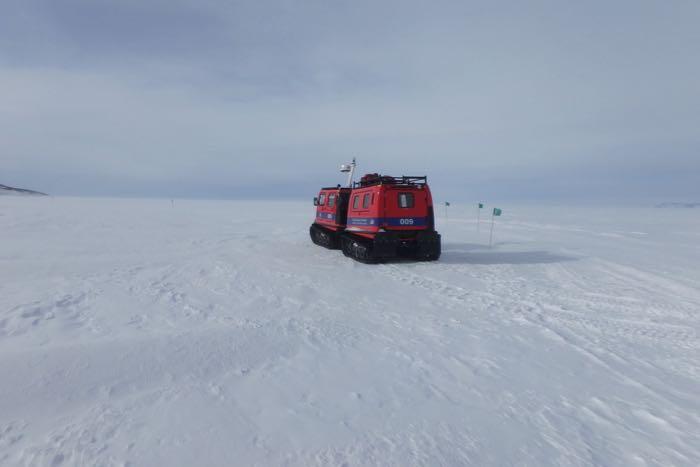 The Hagglund out on the sea ice
The Hagglund out on the sea ice
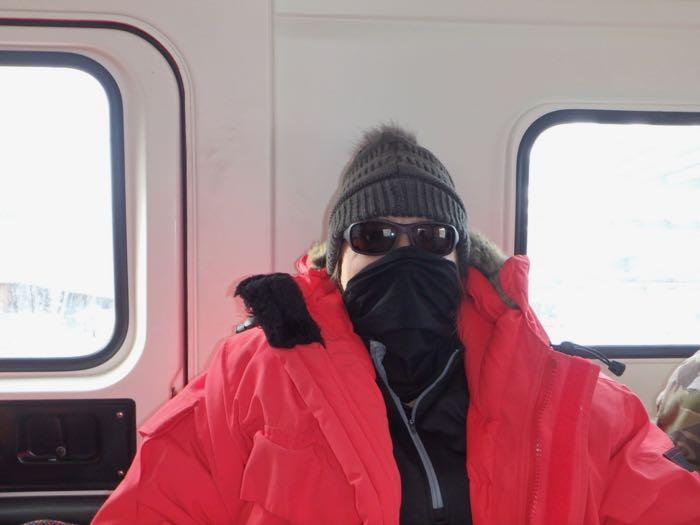 Denise Hardoy riding in the Hagglund
Denise Hardoy riding in the Hagglund
Ice Formation
Sea ice forms when the air temperature cools the ocean to -2.2 degrees C. If the water is turbulent, it forms in pancakes that crash together, eventually freezing in to a rough solid mass. If the water is calm, it freezes into a giant skating ring called Nilas ice. As the temperature continues to drop, the ice thickens, growing platelet ice from below. Most of this sea ice breaks up and drifts north, and melts in the summer, only to reform again the next fall. Some cracks are predictable- happening in virtually the same place every year.
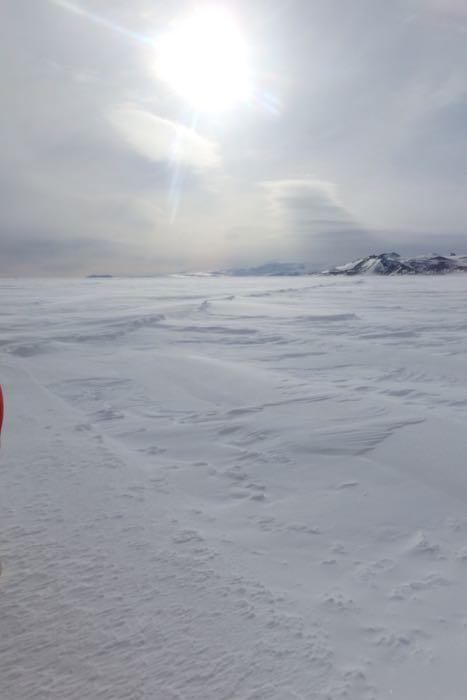 Pressure ridge formed from two colliding ice plates.
Pressure ridge formed from two colliding ice plates.
The huge sheets of solid ice act kind of like the tectonic plates of Earth's crust. They are under tremendous pressure to move from wind, waves, currents and tides. Thats when cracks can occur. If the two plates of ice move apart, the crack widens- just like a divergent boundary. If the plates are pushed together, it forms a mini- ice mountain range- like a convergent boundary. The two ice sheets can even slide past each other just like a transform boundary that creates earthquakes. Land features like islands, peninsulas, and even icebergs(made of fresh water) can cause cracks when the sea ice moves but the land does not.
Play it Safe
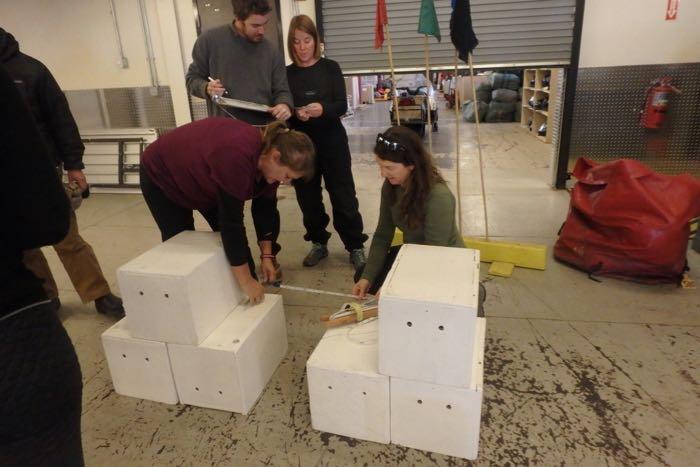 Denise Hardoy and Amy Osborne practice measuring sea ice cracks
Denise Hardoy and Amy Osborne practice measuring sea ice cracks
So, safety around these cracks in the ice seems simple. Just don't drive over them, right? Unfortunately, it's not quite that easy. They can be completely covered by snow. You might not even know they are there. You may see a slight ridge, or notice a few seals hanging around as your only clues. Seals need air, so they will only be where there is open water somewhere. Only rarely will you actually see a gap with water in it. It usually freezes right up.
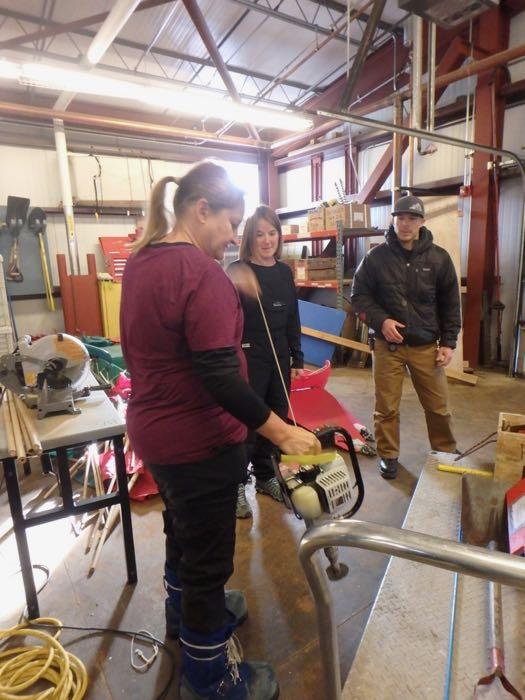 Denise Hardoy starting up the ice drill
Denise Hardoy starting up the ice drill
Fortunately, there is a group of people down here that go out on the ice and monitor all of the cracks...lining a safe path with flags. Green and red are good to go...but black means danger and do not approach.
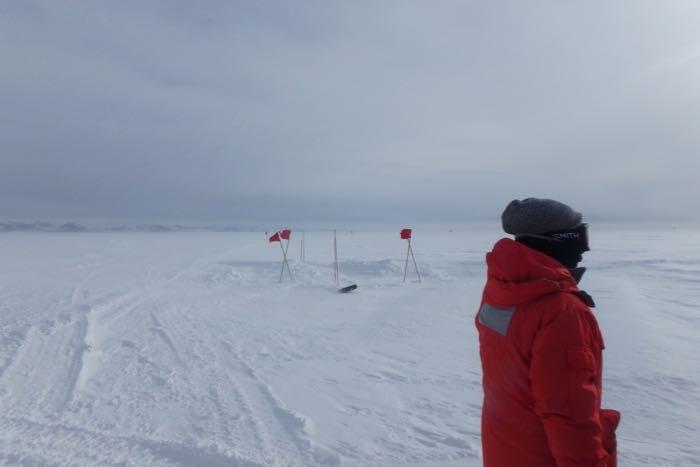 Red flags mark a sea crack crossing
Red flags mark a sea crack crossing
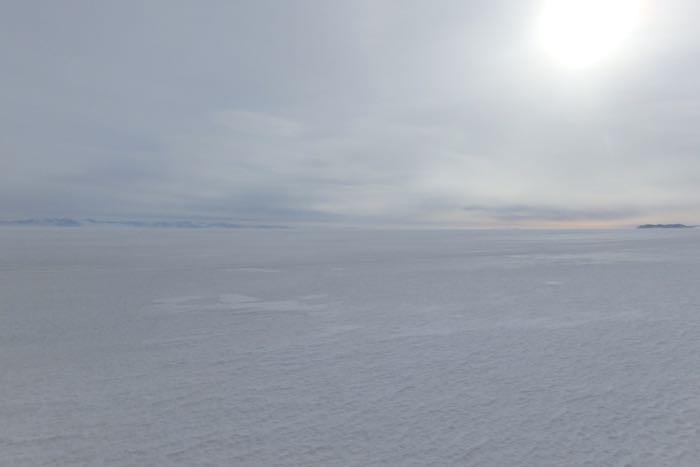 Wind and blowing snow can obscure cracks in the sea ice
Wind and blowing snow can obscure cracks in the sea ice
All vehicles still need to pay attention to ice cracks though, even when staying on the flag marked path. In today's class, we learned how to profile a sea ice crack. This is a way to determine if the crack is safe to cross with your vehicle. Safety depends on several factors- the length of your vehicle's tracks, the thickness of the ice, and the gap between sufficiently thick ice. We learned how to measure the crack width, how to drill holes, and how to use the holes to determine the depth of the ice. The tricky part is that not all cracks are created equal...
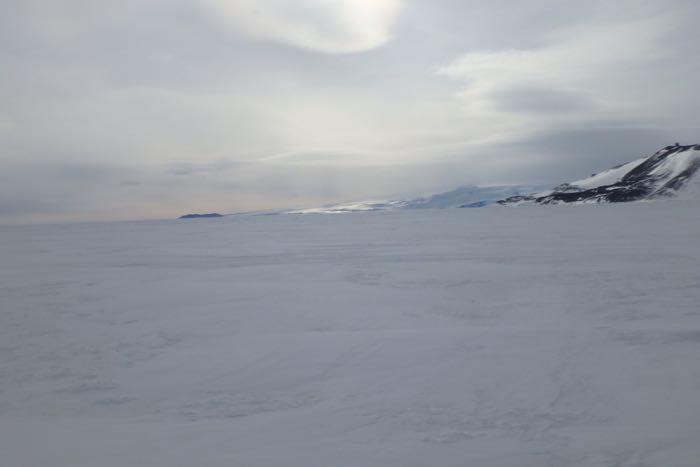 Sea ice cracks are difficult to see. Can you find it?
Sea ice cracks are difficult to see. Can you find it?
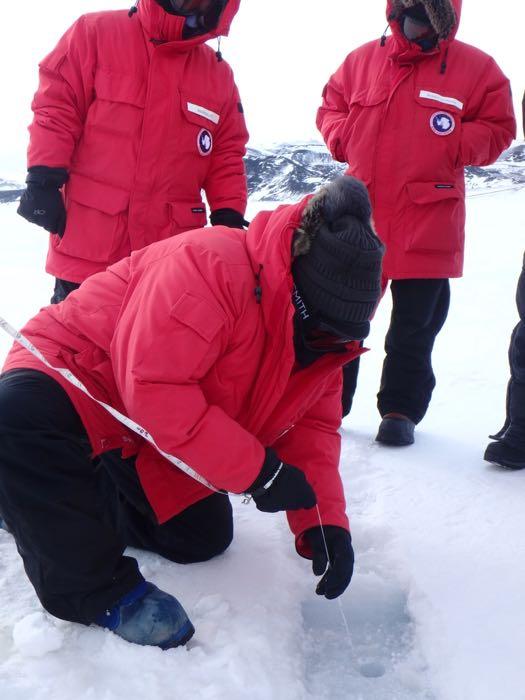 Denise Hardoy measuring the thickness of the sea ice.
Denise Hardoy measuring the thickness of the sea ice.
Many cracks form, refreeze, and reform, causing a stair-step affect of different thicknesses of ice. You have to determine the thickness of each level to decide if your vehicle can make it safely across the entire gap.
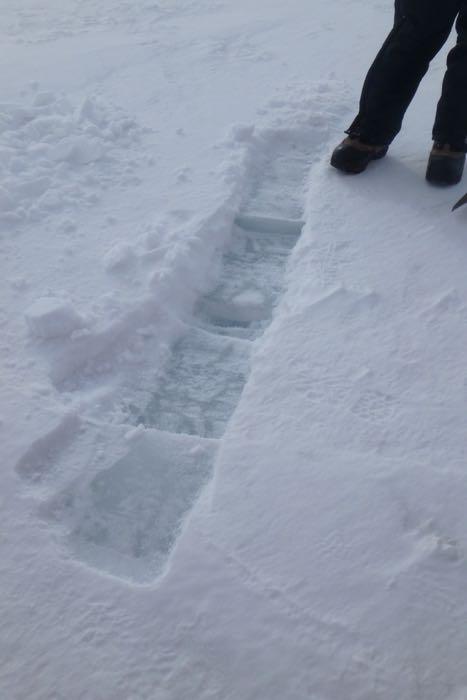 Steps form when and ice crack separates and re-freezes.
Steps form when and ice crack separates and re-freezes.
I am fortunate to have a team with many years experience driving on the sea ice, so I feel very safe.
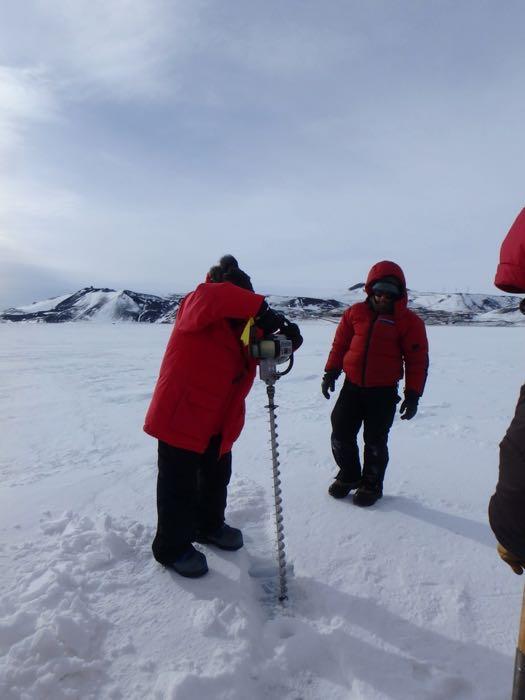 Denise Hardoy drilling in the sea ice.
Denise Hardoy drilling in the sea ice.
It was fun to get to fire up the drill and drill holes in the ice. You know you are over the ocean, but it was still kind of surprising when the drill went through and sea water flooded up through the hole. I was kind of surprised how easy it was to drill in the ice. I think that was my favorite part of this sea ice training day. PA231426.m4v
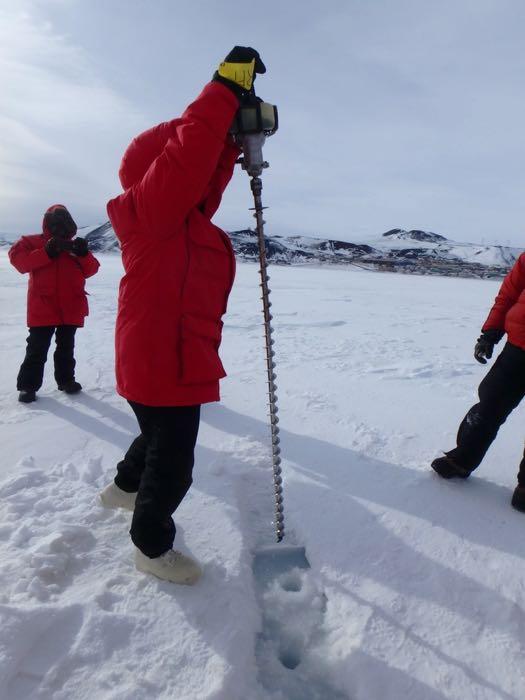 Parker Levinson removing the drill from the ice hole
Parker Levinson removing the drill from the ice hole
Shout Out
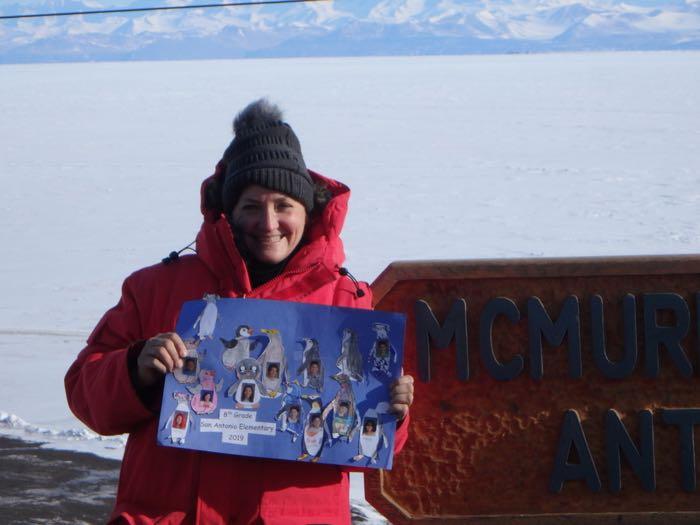 San Antonio 8th grade class penguins
San Antonio 8th grade class penguins
Here is our amazing San Antonio 8th grade class penguins! I feel like you are here with me. Thanks for following my journal and please ask me some questions! I am looking forward to sharing this experience with you all when I return.
Today's Weather
I got to really experience Antarctic weather today. The wind was blowing at 40 knots today. How fast do you think that is in Miles Per Hour??? It dropped the windchill to somewhere around -40 F. That hasn't been too bad for short walks around the station, but today's training was outside all afternoon. The wind was blowing so hard that it kind of pushed you around. I was so happy for my Big Red. I wore my big blue boots with two sock liners and a super thick pair of wool socks. Next, I had on four layers of different types of pants- wool, fleece, and windproof exteriors. I wore three shirts, a fleece jacket, and my Big Red Parka.Then I had ski gloves with wool liners, goggles, a neck gaitor, face mask, and a hat. Sometimes I even had to put up my hood to keep the rest of the wind out. I was pretty much warm the whole time. Of course, it was also hard to move around and do any work, but we managed. I was totally stoked to complete the sea ice training today!
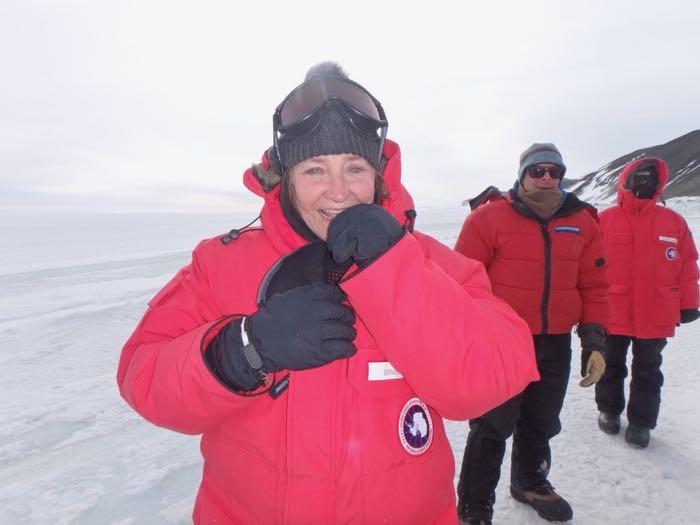 Denise Hardoy finished sea ice training!
Denise Hardoy finished sea ice training!
Tomorrow....
Tomorrow, I will train on the snowmobiles(They call them Sno Mos down here) and learn how to use handheld GPS devices. Then, on Saturday, I can finally go out with out team for a day collecting fish at the dive hut! I can't wait!
Stay Cool,


Comments
Add new comment